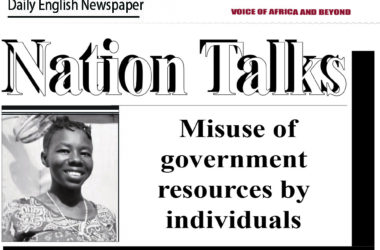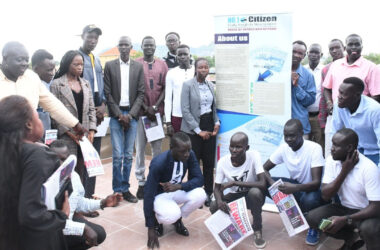To start with, our currency SSP (South Sudanese Pound) has reached 1,000., (One Thousand SSP) to (one) 1 US$ Dollar from the Original 1US$ (Dollar) equal to 2 SSP and it is still climbing up more.
The underlying reason for its continuous depreciation is because South Sudan is characterized by over-dependency on external trade where all the household needs are satisfied by exchanging Oil with all household items from other parts of the world through foreign trade. There are: no large-scale commercial agricultural farms with the exception of Renk which is operational to a very limited range; no manufacturing; no factories – even the old factories were not resuscitated. In brief, with no Oil flow to the International markets – South Sudan is forever doomed.
What is to be done
What is needed are efforts of every South Sudanese from all walks of life to contribute to the betterment of South Sudan – be they politicians, businessmen and women including private individuals.
On my part as a private individual – this is my testimony
I formulated the Preliminary Project Concept Note in 2018 for the establishment of the National Development Corporation of South Sudan not on the model of the High Executive Council of Southern Region Juba of Sudan 1972- 1983 but on the model of Tanganyika which later on became Tanzania after amalgamating with Zanzibar Island.
Due to very limited resources available, South Sudan Development Corporation of the High Executive Council of Southern Region – Juba restricted itself to business research only. Whereas, Tanganyika National Development Corporation under ‘Muaalim’ Julius Nyerere had leeway for diversification because of being an independent Country called Tanganyika. The name of the National Development Corporation of Tanganyika was later on changed to the National Development Corporation of Tanzania after amalgamating with Zanzibar Island.
Many Copies
In that respect, I printed many copies of the Preliminary Project Concept Note using my own resources and took those copies to all the Departments of the Government of South Sudan with a dispatch book that I had designed. The only Ministry that did not receive a copy of the Project Concept Note was the Ministry of National Security. The officer at the reception refused to sign the dispatched book – may be for security reasons which was a very minute issue.
Deliberations
During my deliberations, I had assumed that someone, somewhere there may pick up the concept note and share it with his/her colleagues for discussion so as to have a chance of their ownership for eventual implementation which never happened. Later, in a different development: a new Minister of Trade and Industry by name Kuol Athian Mawien and his new Undersecretary by name Agaak Achuil Lual initiated the idea of establishing the National Development Corporation of South Sudan; they got stuck on some aspects and especially, the Laws governing the proposed National Development Corporation. The 21 years of the Sudan Civil War (1983 – 2005 had erased all reference points.
After learning about their initiative and difficulties I advised them to contact the South Sudan Ambassador to Tanzania while at the same time, I gave them a copy of my Preliminary Project Concept Note for the Creation of the National Development Corporation of South Sudan.
Progress done
I don’t know the level of progress they have made now. Yet, one thing is for certain, the creation of the National Development Corporation of South Sudan would have been visible in the Market place if it was completed and functioning.
Part of the skeleton of the concept note
In that respect, the Organization Chart of the conceived National Development Corporation of South Sudan which is still in limbo embodied the following Departments or Units which could be increased, decreased, or remain the same:
- Department of Institutional Investment (DII) 2. Department of Information Technology (DIT) 3. Department for Resuscitating Past Business Institutions (DRPBI) 4. Department for Agricultural Production (DAP) 5. Department for Large Scale Enterprises’ Investment (DLSEI) 6. Department for Small Scale Enterprises’ Investment (DSSEI) 7. Department for Business Research (DBR) 8. Department for Innovation (DI) 9. Department for Marketing (DM) 10. Department for Human Resources (HR) 11. Department for Strategic Food Reserves (DFSFR).
Recall
For the reader to get an insight of what I am describing – let me recall the High Executive Council (1972 -1983) era showing institutions that contributed to the economy at that time of what is now geographically known as South Sudan which at the present moment is now sadly lacking.
- There was Anzara Sugar and Anzara cotton cloth which was a contribution of the English during the Anglo Egyptian Sudan rule (1898 – to end of 1955).
- There were teak plantations started by the English of Anglo Egyptian Sudan which continued to flourish and interrupted only by the Civil Wars.
- There was a railway line to Wau constructed by the Central Government in Khartoum – the Capital of Sudan as their contribution to the economy of Sudan.
- There was Wau Fruits and Meat Canning Factory which was a contribution by the Central Government – Khartoum through the help of what is now Russian Federation.
- There was Wau Beer Factory which was a contribution from the Central Government – Khartoum. The factory did not start functioning because Sudan Government under Jaafar Muhammed Nimeiri resorted abruptly to Islamic principles which prohibit beer consumption.
- There was Aweil Rice Scheme which was a contribution from the Central Government – Khartoum. The rice produced was the main raw material, ingredient for which the experts of the Beer Factory had planned to be used in the Beer Factory in the Wau but unfortunately it never took off.
- There was Wau Vocational which was constructed by the Central Government – Khartoum and the machines were donated by the Germans.
- There was Wau Metal-Craft and Handicraft Cooperatives initiated by the Ministry of Cooperatives and rural Development.
- There was Tonj Kenaf which was constructed by the Central Government – Khartoum. It had reached the operational stage at the start of the Second Civil War -1983 -2005.
- There was Malakal Boatbuilding and Fisheries Cooperatives which was funded by the ILO (International Labour Organization) and Implemented by the Regional Ministry Cooperatives and Rural Development.
- There was Source Youbo Pineapple Production which was a contribution of the Regional Ministry of Agriculture.
- There was Yei Coffee Marketing Cooperatives which was a joint contribution of the Regional Ministry of Cooperatives and Rural Development and the Regional Ministry of Agriculture.
- There was Haggar Tea Production in Yei which was a contribution of Haggar Company.
- There was the Multiple Training Center in Juba which was a contribution from International NGOs – after independence it has been resuscitated but Wau Vocational was not brought back to life.
- There was Upper Talanga Irish Potatoes Production which was a contribution from Norwegian Church Aid (NCA). It was in full production until the civil war started in 1983.
- There was Mongola Agro Industrial Complex which was an input from different Ministries of the High Executive Council including International NGOs, but could not takeoff because of opposition from the Central Government in Khartoum. If a person happens to visit Mongola, one can see the rusted factory machines in the open field.
In that respect, the High Executive Council had predicted that the Central Government in Khartoum would prevent the shipment of factory machines after completion of the Premises of the Factory – therefore, they decided to bring the machines in advance. In a counter negative development, the Central Government in Khartoum predicted the High Executive Council move and stopped the purchase of steel and cement which were the main ingredients of construction of the Factory Premises.
- There was Mongala Sugar: sugarcane plantation was started and samples of sugarcanes were being sold at Juba market and the construction was stopped by the outbreak of the Second Civil War 1983 – 2005.
- There was River transport system which was created by the English and continued to operate under the Central Government in Khartoum and South Sudan for unknown reasons distanced itself from the operation of the River Transport which joins the states Upper Nile, Bahr El Ghazal and Equatoria.
- Finally, there was the Railway Line to Wau which was a contribution of the Central Government – Khartoum in order to ease transport from Northern Sudan to Bahr El Ghazal which used to be through Shambe River Port and very far away from the rest of Bahr El Ghazal Districts.
- In that respect, after Independence of South Sudan, the Railway line could have been extended to the whole of Equatoria as well as other parts of Bahr El Ghazal Districts – leaving Upper Nile to a later date due to its soil condition which is deep, black cotton soil which develops cracks that goes to more than ten (10) meters deep automatically at every dry season. As such, Upper Nile soil requires more feasibility studies.
- There was also an International NGO, helping and teaching the locals in Juba how to make sandal shoes from leather.
Missing links
All those Business and Service Institutions should have been resuscitated and some others added for the benefit of all South Sudanese.
The author can be reached via Tel: 0914256908, 0922761025; Email: Josephlang2020@gmail.com, langjr2002@yahoo.com




